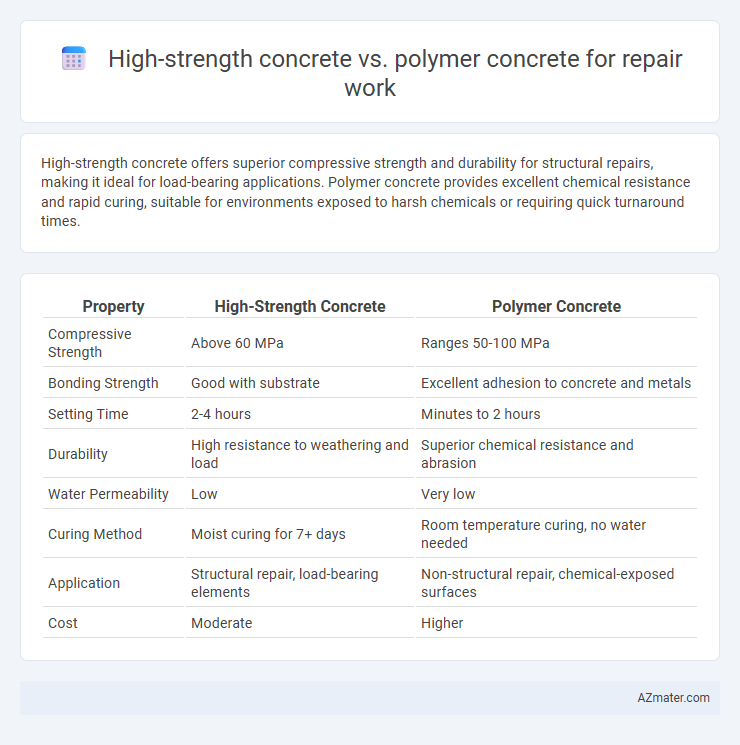High-strength concrete offers superior compressive strength and durability for structural repairs, making it ideal for load-bearing applications. Polymer concrete provides excellent chemical resistance and rapid curing, suitable for environments exposed to harsh chemicals or requiring quick turnaround times.
Table of Comparison
| Property | High-Strength Concrete | Polymer Concrete |
|---|---|---|
| Compressive Strength | Above 60 MPa | Ranges 50-100 MPa |
| Bonding Strength | Good with substrate | Excellent adhesion to concrete and metals |
| Setting Time | 2-4 hours | Minutes to 2 hours |
| Durability | High resistance to weathering and load | Superior chemical resistance and abrasion |
| Water Permeability | Low | Very low |
| Curing Method | Moist curing for 7+ days | Room temperature curing, no water needed |
| Application | Structural repair, load-bearing elements | Non-structural repair, chemical-exposed surfaces |
| Cost | Moderate | Higher |
Introduction to High-Strength and Polymer Concrete
High-strength concrete is engineered with a low water-cement ratio and supplementary cementitious materials to achieve compressive strengths exceeding 6,000 psi, making it ideal for structural repairs requiring durability and load-bearing capacity. Polymer concrete incorporates polymer binders instead of traditional cement, offering superior chemical resistance, rapid curing times, and excellent adhesion to existing substrates, suitable for specialized repair environments. Both materials address critical repair needs but differ in mechanical performance, curing behavior, and environmental resistance properties.
Key Characteristics of High-Strength Concrete
High-strength concrete features a compressive strength exceeding 6,000 psi, exceptional durability, and low permeability, making it ideal for structural repair work requiring long-term performance. Its dense microstructure provides enhanced resistance to chemical attack, freeze-thaw cycles, and abrasion compared to standard concrete mixes. The material's compatibility with existing concrete substrates and ability to bear heavy loads highlight its suitability for critical infrastructure restoration.
Essential Properties of Polymer Concrete
Polymer concrete exhibits superior chemical resistance, rapid curing times, and exceptional adhesion to existing substrates, making it ideal for structural repair work. Its high tensile strength and low permeability prevent water ingress and chemical attack, ensuring long-term durability in aggressive environments. Unlike high-strength concrete, polymer concrete offers enhanced flexibility and shrinkage resistance, reducing the risk of cracking and improving repair longevity.
Application Areas in Repair Works
High-strength concrete excels in structural repair applications requiring load-bearing capacity, such as bridge decks, columns, and beams, due to its enhanced compressive strength and durability. Polymer concrete is ideal for repairing non-structural elements like chemical-resistant floors, industrial slabs, and corrosion-prone surfaces, benefiting from its superior chemical resistance and adhesive properties. Both materials are chosen based on specific repair demands, with high-strength concrete preferred for mechanical stress zones and polymer concrete favored in aggressive environmental conditions.
Strength and Durability Comparison
High-strength concrete exhibits compressive strengths typically ranging from 6,000 to 12,000 psi, providing excellent load-bearing capacity and resistance to mechanical stress during repair work. Polymer concrete, enhanced with resins, offers superior chemical resistance and nearly impermeable properties, contributing to exceptional durability in harsh environments. While high-strength concrete excels in structural load performance, polymer concrete outperforms in durability against chemicals, moisture, and abrasion, making it ideal for specialized repair applications requiring long-term resilience.
Bonding and Adhesion Performance
High-strength concrete offers excellent compressive strength but often exhibits lower bonding and adhesion performance compared to polymer concrete, which integrates polymer resins to enhance chemical affinity and flexibility at the repair interface. Polymer concrete provides superior adhesion to existing substrates, reducing the likelihood of delamination and ensuring durable repairs in dynamic or moisture-prone environments. The enhanced bonding properties of polymer concrete make it especially suitable for patch repairs and structural rehabilitation where long-term adhesion is critical.
Chemical and Environmental Resistance
High-strength concrete offers exceptional compressive strength but exhibits limited resistance to chemical attacks, especially from acids and sulfates commonly found in industrial environments. Polymer concrete, formulated with resin binders, provides superior chemical resistance, effectively withstanding aggressive chemicals, oils, and solvents while also exhibiting low permeability and enhanced durability in harsh environmental conditions. For repair work in chemically aggressive or environmentally exposed settings, polymer concrete ensures longer-lasting performance and reduced maintenance compared to high-strength concrete.
Installation and Curing Time Differences
High-strength concrete typically requires longer curing times of 7 to 28 days to achieve optimal durability and strength, which can delay repair project completion. Polymer concrete offers significantly faster installation due to rapid curing, often within 24 to 48 hours, allowing for minimal downtime and quicker return to service. Choosing polymer concrete enhances efficiency in urgent repair scenarios where expedited curing and early strength gain are critical.
Cost Analysis and Economic Considerations
High-strength concrete offers a lower initial material cost compared to polymer concrete but may incur higher long-term maintenance expenses due to susceptibility to chemical attacks and crack propagation. Polymer concrete, though having a higher upfront cost, provides superior durability, chemical resistance, and faster curing times, reducing labor costs and downtime in repair projects. Economic considerations favor polymer concrete in environments requiring frequent repairs or exposure to harsh chemicals, as its lifecycle cost savings offset the initial investment.
Choosing the Right Concrete for Repair Jobs
High-strength concrete offers superior compressive strength and durability, making it ideal for structural repairs subjected to heavy loads and harsh environmental conditions. Polymer concrete, composed of organic polymer binders instead of cement, provides excellent chemical resistance and rapid curing, suitable for repairs in corrosive environments or where downtime must be minimized. Selecting the right concrete depends on load requirements, exposure conditions, curing time, and specific repair objectives to ensure longevity and performance.

Infographic: High-strength concrete vs Polymer concrete for Repair work
 azmater.com
azmater.com